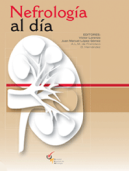We read with great interest the article titled “Glomerular disease in chronic graft versus host disease” by Peluffo et al., which highlights a rare, but important complication of the chronic graft- versus-host disease (GVHD) – glomerular disease after allogeneic stem cell transplantation (ASCT).1 The authors deserve a huge credit for addressing histopathological and clinical patterns of the renal involvement in cGVHD patients, however, we would like to present several points for consideration regarding it's methodology, interpretation and generalizability.
Seven patients biopsied during the study period were included. Four were male and three were female. We are writing this to express concern on small sample size included in study period. These types of studies are relatively straightforward and are well suited for publication, but they make difficult to detect true effects, so they are not as such reliable and reduce generalizability of findings to the broader population. In contrast larger sample sizes are more accurate and reduce false positive results.2
The exclusion criteria are important in study design to ensure participants safety, to minimize confounding variables, maintain ethical standards, enhancing the validity of study. The absence of such criteria restricts the generalizability of findings and raises question on homogeneity of the study. I respectfully suggest that well justified exclusion criteria must be addressed in future study.3
The calcineurin inhibitor – Cyclosporine used frequently in this study as prophylaxis of GVHD is itself a nephrotoxic drug.4 Glomerular disease i.e., Thrombotic micro-Pathy is well known to be caused by calcineurin inhibitors (CNIs).5 The authors did not assess whether the nephrotoxic effects are truly caused by GVHD, or they are the side effects of the calcineurin inhibitors, and the authors also didn’t report the serum levels and monitoring of Cyclosporine.6 This omission limits the causality between cGVHD and kidney diseases in this study. Therefore, I believe this point need further discussion in future research on glomerular disease after allogeneic stem cell transplantation (ASCT).
A limitation of this study lies in the wide and heterogeneous treatment regimens used for immunosuppression. While corticosteroids were administered to each patient, other drugs like rituximab, mycophenolate mofetil, cyclosporine, and everolimus were used differently in different cases. This heterogeneity in treatment limits the effectiveness of specific therapies. However, rituximab was effective in podocytopathy cases but as this study includes very small sample size, so it prevents any firm conclusions regarding its efficacy.7
The study reports follow-up across patients ranging from just 14 to 100 months (median values often around 24–34 months) While some patients were observed up to ∼8 years (3240 days→∼108 months), this remains limited for glomerular diseases with potential for late relapse—e.g., membranous nephropathy often relapses years later—and for chronic GVHD sequelae. Membranous nephropathy and other glomerulopathies have well-documented patterns of late relapse (5–10+ years post remission).
With most patients only observed ≤8 years, the risk of relapse or progression to CKD/ESRD beyond the follow-up window remains unquantified. The study focuses primarily on remission rates (CR/PR), but does not report long-term outcomes like progression to CKD stages, sustained proteinuria, or GFR trends.
Without extended monitoring, it's impossible to assess chronic kidney disease progression—especially following initial remission. The heterogeneous follow-up durations—e.g., one patient followed for only 14 months vs. another for 100months—introduce inconsistencies in outcome assessment and risk evaluation. Such variability complicates comparisons and pooling of data.8
Overall, this study provides valuable insights into the under recognized complication of GVHD. However, future studies would benefit from including comprehensive drug monitoring, treatment homogeneity, larger sample size, and a systematic evaluation of Calcineurin inhibitors toxicity to fully clarify underlying causes of glomerular diseases in these patients. We are looking forward to seeing further research on this topic.
Conflicts of interestThe authors declare no conflicts of interest.






